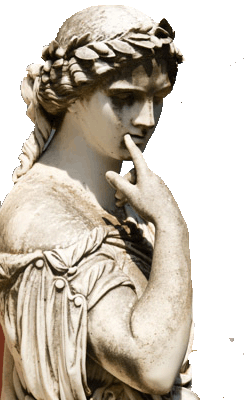FIRST SCENE

The alternative interpretation holds that the woman is the decedent, Adelphia herself, who in the next two scenes will be taken into the presence of Sophia, the personification of Wisdom. This first scene would have her drawing water from the well of Wisdom during her life on earth. Proponents of this interpretation make the bearded man the "Ancient of Days," the name given to God in Daniel 7:9,13, but that is unnecessary to the theory and just complicates it. A problem is that the Wisdom interpretation does not give a satisfactory explanation for the standing male figure. However, the next two scenes do support the Wisdom interpretation more satisfactorily.
SECOND SCENE
By dress and coiffure the woman in the center of the second scene appears to be the same as the one in the first. She is looking past her companions towards the enthroned person on the right. The companions are also bare-headed. They have slightly longer coifs, but the same simple tunics and belts. For those who support Virgin Mary theory, this second scene shows Mary being conducted to her throne in Heaven. In the Wisdom theory the decedent is being conducted into the presence of Sophia.
THIRD SCENE

The Virgin Mary theory would necessitate positing a later date for the lid than for the case, which by its style is thought to be from the second quarter of the 4th century, too early for a cult of Mary. Nor does it explain the visual allusion to Polyhymnia. On the other hand there is no chronological problem if the woman on the throne is Wisdom, and it would make perfect sense for her to be accompanied by a figure representing eloquence in matters divine.
The Wisdom theory would also explain why the woman featured in the second scene is casting her gaze at the one on the throne: Conducted into the presence of divine Wisdom after a life of seeking wisdom in the world, she is given a place at the feet of Sophia, no longer in the humble weeds of her earthly life but wearing the palla like the others.
In Christian typology Wisdom is Christ, the gender difference notwithstanding. So in the Wisdom theory the decedent would be taking her place in Heaven at the feet of the Lord. If the lid is in fact contemporaneous with the case, it may be no accident that directly below the scene of Adelphia at the feet of Wisdom is the woman with the flow of blood kneeling at the feet of Jesus, who in the Vulgate Matthew says, Confide filia fides tua te salvam fecit, "Courage daughter, your faith has saved you" (9:22).
View the first scene in full resolution
View the second scene in full resolution
View the third scene in full resolution
View the entire sarcophagus
Read more about the Annunciation.
Photographed at the Syracuse Archeological Museum by Richard Stracke, shared under Attribution-NonCommercial-ShareAlike license.
